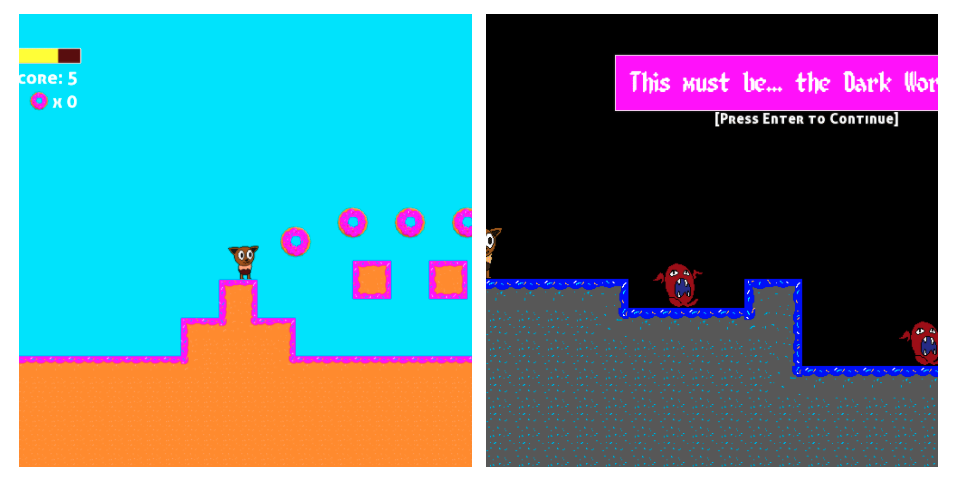Game space is the world in which games take place. This game space includes colors, sounds, and barriers, which all help determine the events that take place, what a player sees, and how they interact with the game.
Colors
Colors are an extremely important part of video games, and thus, game space. When making a game, creators need to decide how colors will influence player interaction with their worlds.
Here are some classic examples of how to use color effectively in games:
-Changing an enemy's color to indicate their ability to issue damage
-Changing the color of a player to indicate they have a power-up
-Changing the color of the background to indicate the level difficulty is changing
-Using a different colored door to indicate that the player should check it out
For instance, the game on the left below is brightly colored, while the game on the right is darker—which indicates different space and worlds between the two.

All of that said, color should be used with caution. With potentially large audiences, it's never known just exactly who will be sitting down to play a game. What if a player is color blind? Will they experience the game the same way the creator intended?
Sounds
Sounds in games come in many different forms and styles. When creators are deciding where to add sound to games, a good rule to follow is to use music to help impact situations.
For instance, good uses of sounds include landing a hit on an enemy and creating tension for a boss fight.
Take a listen to Zelda below. Anyone familiar with the game can probably close their eyes and still see the action unfolding thanks to the classic soundtrack.
A common error when using sounds in games is overusing them. It's easy to play a sound whenever a player performs a repeating action, but if that sound constantly occurs, the player will get sick of it, and even to the point where they might tune it out, turn off the sound, or stop playing altogether!
Barriers
Barriers control player location and where they're allowed to go. You'll find several different types of barriers in video games.
The Screen
A lesser-known barrier type is the screen itself. This type of barrier is what the player can actually see. Sometimes creators will keep things off the screen until it’s time to show the player. This could include enemies spawning.
Environmental Walls
The best form of barrier utilizes the environment, such as rocks or fences, to block a player. These keep the player contained in the level, but still help them feel as though it's part of the world.
For example, these mountains block a player from passing , and help contain a player in this space.

Invisible Walls
In some instances, barriers are invisible walls that keep the player from going past a certain point (these types of barriers should be used sparingly).
For example, this entire edge below of pink clouds above is an invisible wall given that the player can see them in the distance, but can’t actually jump off into them.
So, happy building! Here’s a recap:
Colors can indicate differences in gameplay, such as enemy types or areas of a level. Sounds can provide feedback to different actions, letting players know when something is effective or not. Barriers can limit the size of the game space and lead players toward the correct path.
